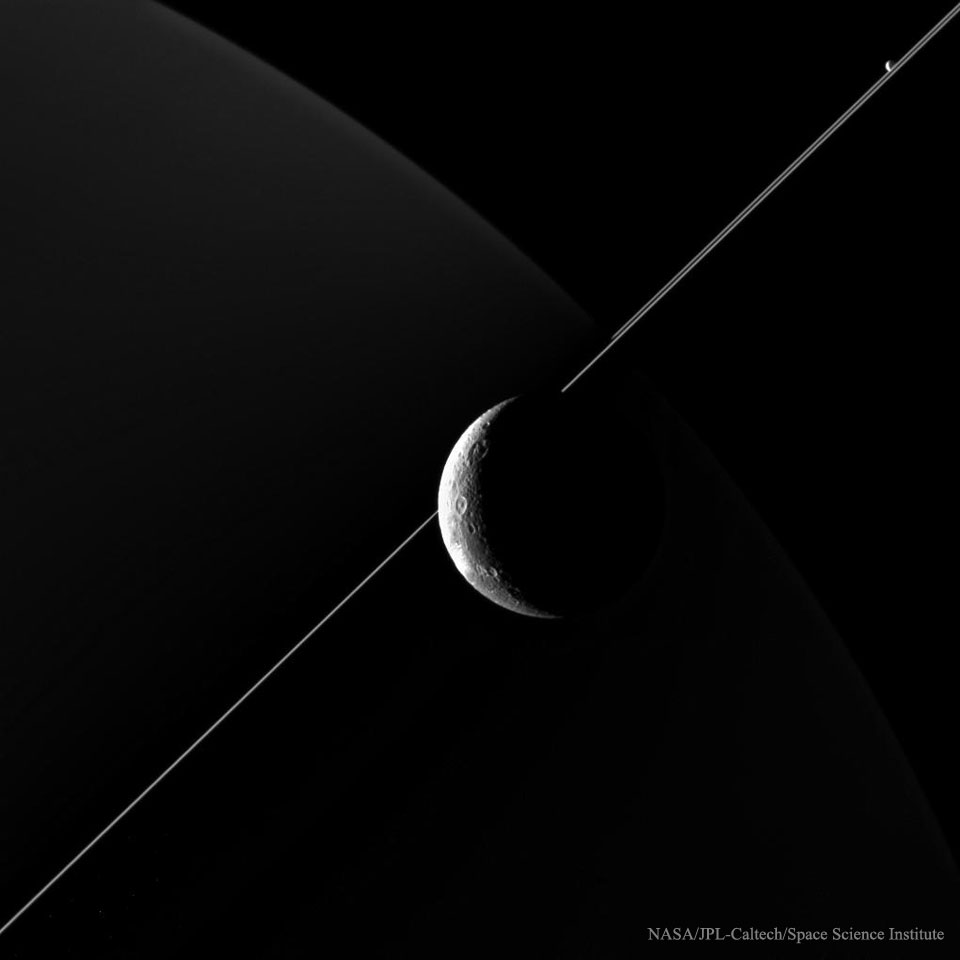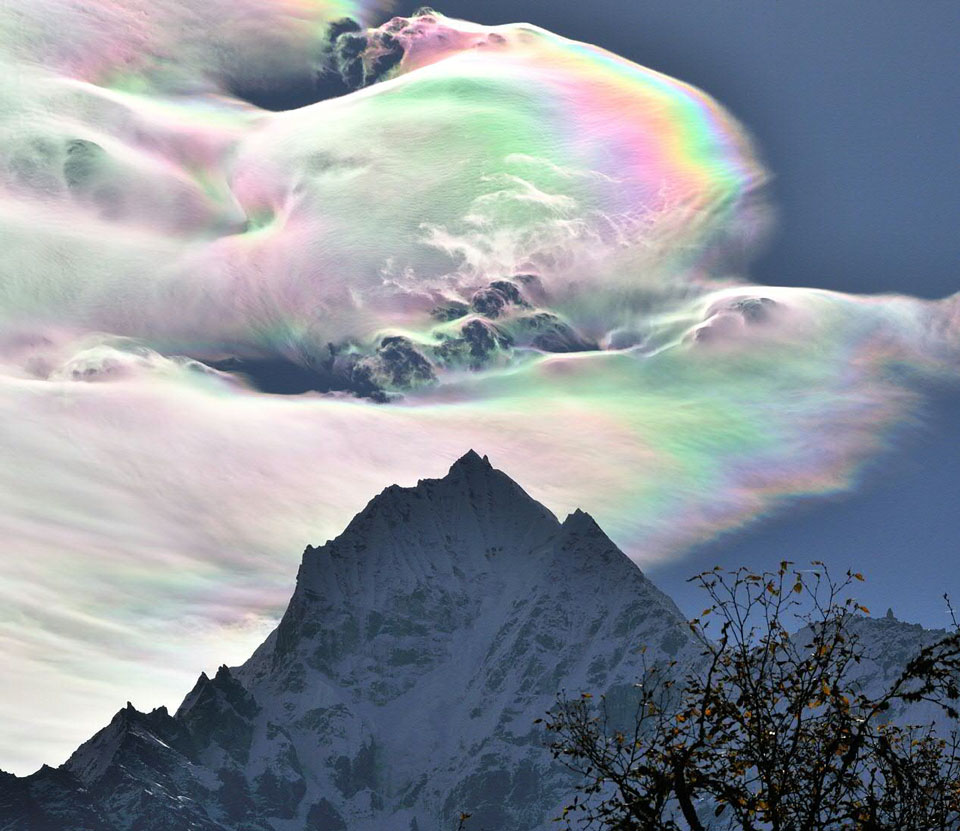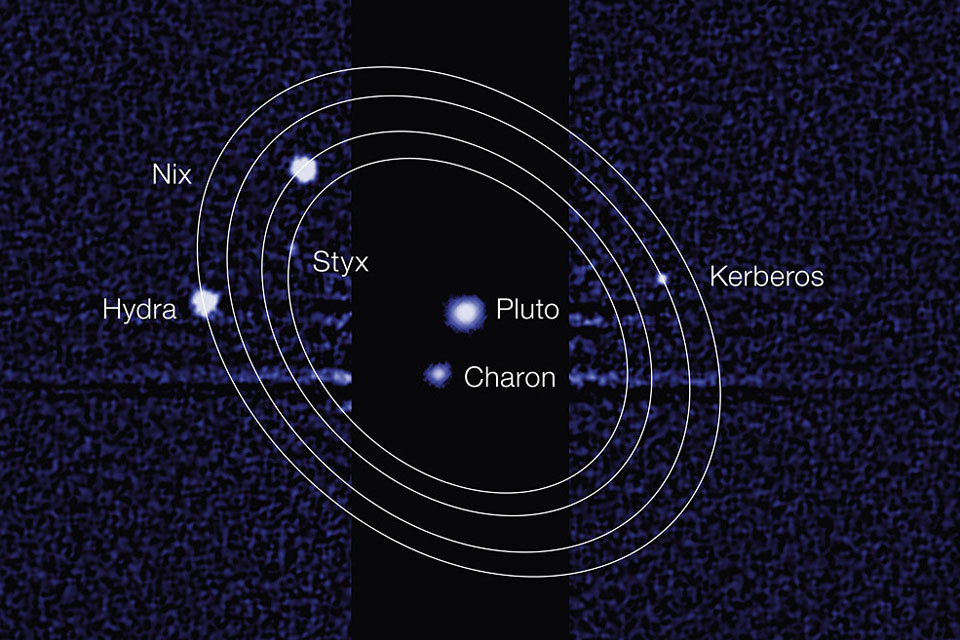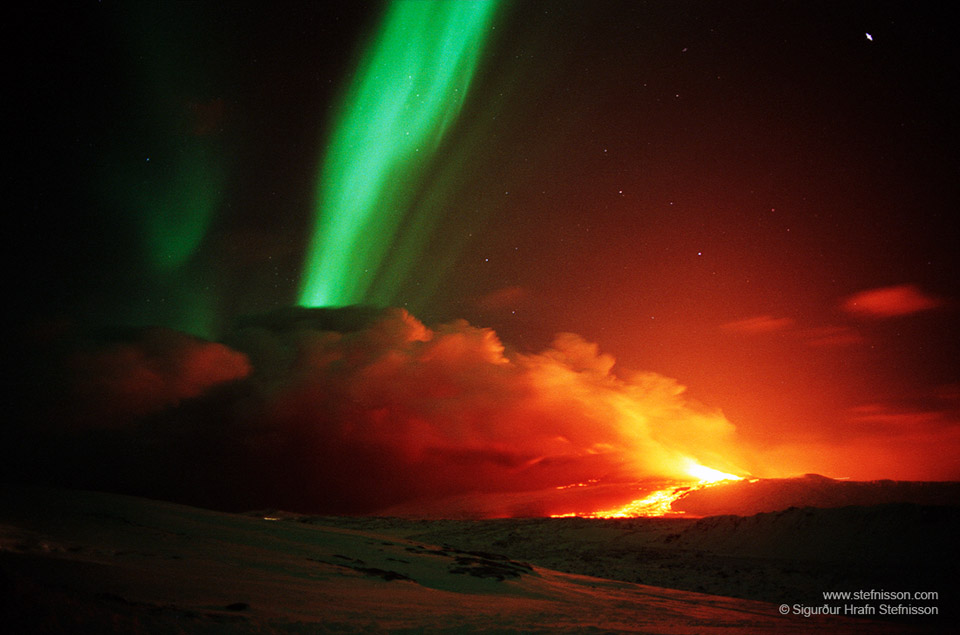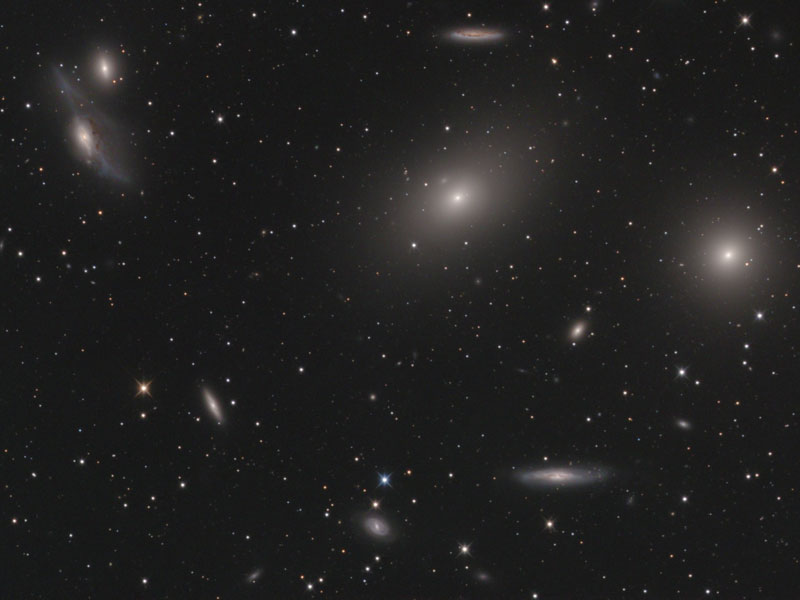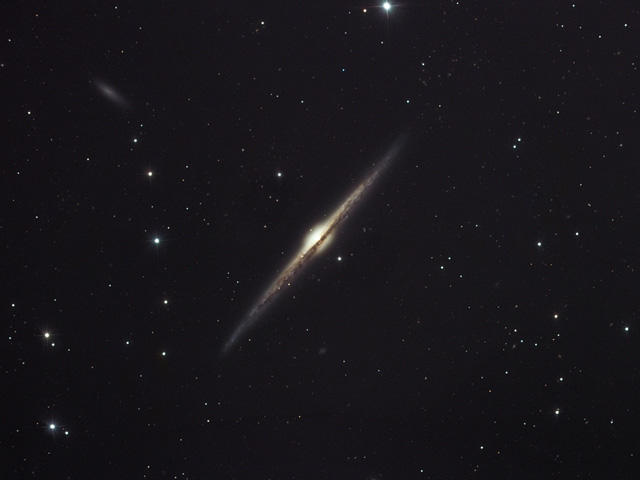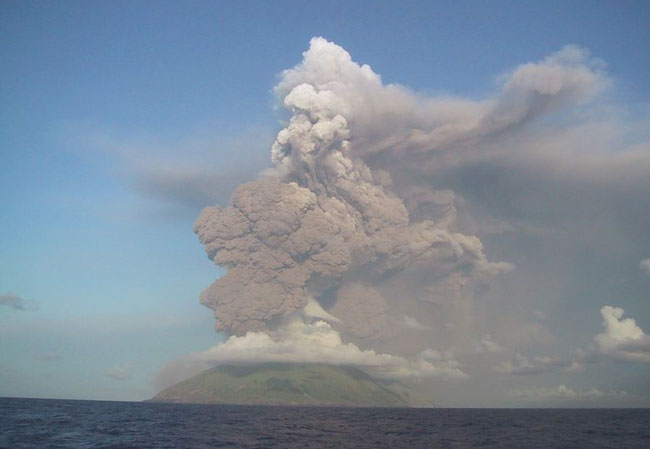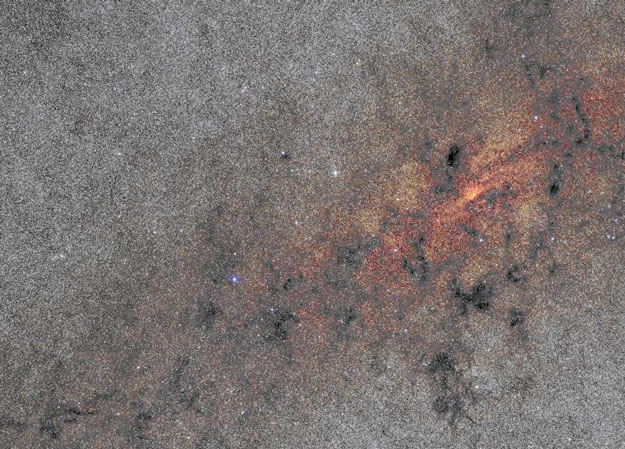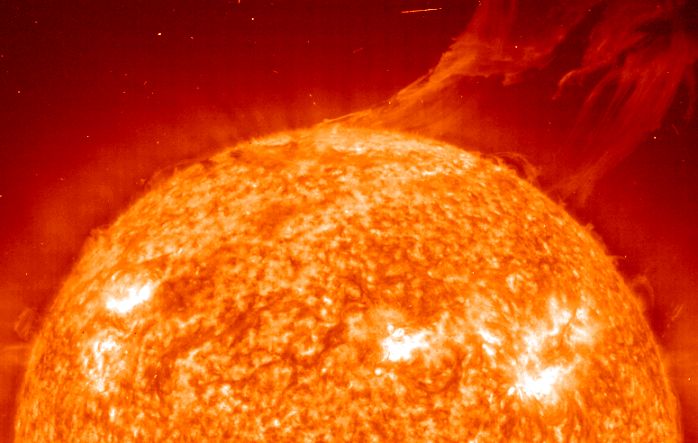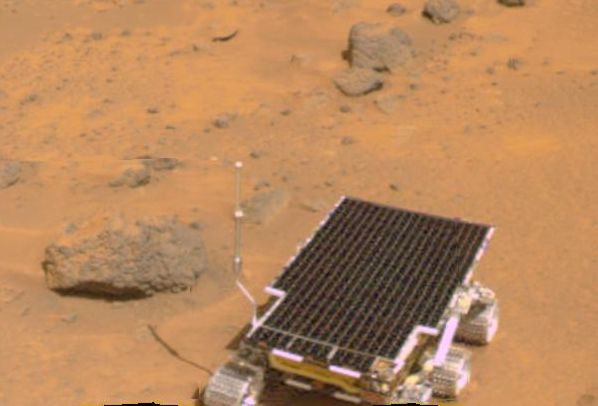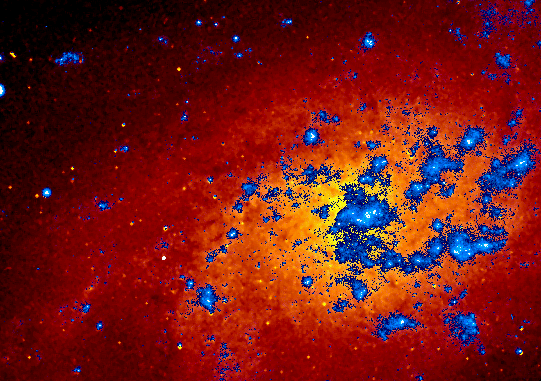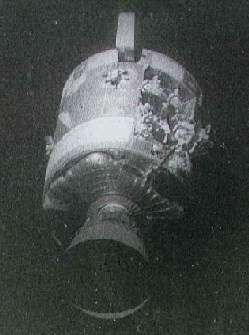| << Previous | Index | Next >> |
2015 That is not our Moon. It's Dione, and it's a moon of Saturn. The robotic Cassini spacecraft took the featured image during a flyby of Saturn's cratered Moon last month. Perhaps what makes this image so interesting, though, is the background. First, the large orb looming behind Dione is Saturn itself, faintly lit by sunlight first reflected from the rings. Next, the thin lines running diagonally across the image are the rings of Saturn themselves. The millions of icy rocks that compose Saturn's spectacular rings all orbit Saturn in the same plane, and so appear surprisingly thin when seen nearly edge-on. Front and center, Dione appears in crescent phase, partially lit by the Sun that is off to the lower left. A careful inspection of the ring plane should also locate the moon Enceladus on the upper right.
2014 Why would a cloud appear to be different colors? A relatively rare phenomenon known as iridescent clouds can show unusual colors vividly or a whole spectrum of colors simultaneously. These clouds are formed of small water droplets of nearly uniform size. When the Sun is in the right position and mostly hidden by thick clouds, these thinner clouds significantly diffract sunlight in a nearly coherent manner, with different colors being deflected by different amounts. Therefore, different colors will come to the observer from slightly different directions. Many clouds start with uniform regions that could show iridescence but quickly become too thick, too mixed, or too far from the Sun to exhibit striking colors. The above iridescent cloud was photographed in 2009 from the Himalayan Mountains in Nepal, behind the 6,600-meter peak named Thamserku.
2013 Pluto's newly discovered moons now have names. Known previously as P4 and P5, the International Astronomical Union has now given the fourth and fifth discovered moons of Pluto the names Kerberos and Styx. The small moons were discovered in 2011 and 2012 by the Hubble Space Telescope in preparation for the close passing of the New Horizons spacecraft by Pluto in 2015. Kerberos is named for the many headed dog in Greek mythology that guards the entrance to the underworld, while Styx is named for the goddess who overlooks the mythological river that runs between the Earth and the underworld. Both monikers are related to the name of Pluto, who rules the mythical nether region. Because their reflectivity is unknown, the size of each moon is quite uncertain -- but each is crudely estimated to be about 20 kilometers in diameter. The robotic New Horizons spacecraft is on schedule to pass by Pluto in 2015 and provide the first clear images of the dwarf planet and its companions.
2012 Sometimes both heaven and Earth erupt. In Iceland in 1991, the volcano Hekla erupted at the same time that auroras were visible overhead. Hekla, one of the most famous volcanoes in the world, has erupted at least 20 times over the past millennium, sometimes causing great destruction. The last eruption occurred only twelve years ago but caused only minor damage. The green auroral band occurred fortuitously about 100 kilometers above the erupting lava. Is Earth the Solar System's only planet with both auroras and volcanos?
2011 These tantalizing panoramas follow a remarkable giant storm encircling the northern hemisphere of ringed planet Saturn. Still active, the roiling storm clouds were captured in near-infrared images recorded by the Cassini spacecraft on February 26 and stitched into the high resolution, false-color mosaics. Seen late last year as a prominent bright spot by amateur astronomers when Saturn rose in predawn skies, the powerful storm has grown to enormous proportions. Its north-south extent is nearly 15,000 kilometers and it now stretches completely around the gas giant's northern hemisphere some 300,000 kilometers. Taken about one Saturn day (11 hours) apart, the panoramas show the head of the storm at the left and cover about 150 degrees in longitude. Also a source of radio noise from lightning, the intense storm may be related to seasonal changes as Saturn experiences northern hemisphere spring.
2010 Dim, distant, dwarf planet Pluto can be hard to spot, especially in recent months as it wanders through the crowded starfields of Sagittarius and the central Milky Way. But fortunately for backyard Pluto hunters, it crossed in front of a dark nebula in early July. The diminutive world is marked with two short lines near the center of this skyscape recorded from New Mexico Skies on July 5. Pluto stands out only because obscuring dark nebula Barnard 92 (B92) blocks the background of the Milky Way's congeries of faint, innumerable stars. Another of astronomer E. E. Barnard's cataloged dark markings on the sky, B93, is easy to pick out just left of B92. Prominent at the lower left is open star cluster NGC 6603. In fact, Pluto, dark nebulae, and star cluster all lie within a portion of M24, also known as the Sagittarius Star Cloud, filling most of the frame.
2009 Connecting the Pipe Nebula to the colorful region near bright star Antares is a dark cloud dubbed the Dark River, flowing from the picture's left edge. Murky looking, the Dark River's appearance is caused by dust obscuring background starlight, although the dark nebula contains mostly hydrogen and molecular gas. Surrounded by dust, Antares, a red supergiant star, creates an unusual bright yellowish reflection nebula. Above it, bright blue double star Rho Ophiuchi is embedded in one of the more typical bluish reflection nebulae, while red emission nebulae are also scattered around the region. Globular star cluster M4 is just seen above and right of Antares, though it lies far behind the colorful clouds, at a distance of some 7,000 light-years. The Dark River itself is about 500 light years away. The colorful skyscape is a mosaic of telescopic images spanning nearly 10 degrees (20 Full Moons) across the sky in the constellation Scorpius.
2008 The Virgo Cluster of Galaxies is the closest cluster of galaxies to our Milky Way Galaxy. The Virgo Cluster is so close that it spans more than 5 degrees on the sky - about 10 times the angle made by a full Moon. With its heart lying about 70 million light years distant, the Virgo Cluster is the nearest cluster of galaxies, contains over 2,000 galaxies, and has a noticeable gravitational pull on the galaxies of the Local Group of Galaxies surrounding our Milky Way Galaxy. The cluster contains not only galaxies filled with stars but also gas so hot it glows in X-rays. Motions of galaxies in and around clusters indicate that they contain more dark matter than any visible matter we can see. Pictured above, the heart of the Virgo Cluster includes bright Messier galaxies such as Markarian's Eyes on the upper left, M86 just to the upper right of center, M84 on the far right, as well as spiral galaxy NGC 4388 at the bottom right.
2007 How does a space shuttle that landed in California get back to Florida for its next launch? The answer is by ferry. NASA operates two commercial Boeing 747 airplanes modified to carry a space shuttle on their backs. Designated officially as Shuttle Carrier Aircraft or SCA, the 747s were made for commercial flights but bolstered by NASA with several struts, stabilizers, and electronic monitors. Spanning about 70 meters in length, the two aircraft's combined mass is nearly 150,000 kilograms. Pictured above, the space shuttle Atlantis is shown being ferried back to NASA Kennedy Space Center in Florida in September 1998.
2006 On July 4th, the space shuttle orbiter Discovery rocketed into space on mission STS-121. Now docked with the International Space Station, Discovery orbits planet Earth at about 27 thousand kilometers per hour. But in this dramatic sunset view taken in May, Discovery is approaching the service structures at Kennedy Space Center's launch pad 39B at the blinding speed of (less than) 2 kilometers per hour. Of course, the orbiter, booster rockets, and external fuel tank ride on one of NASA's workhorse crawler transporters. Built for the Apollo program to carry the giant Saturn V rocket, the crawler transporters have seen four decades of service.
2005 Magnificent spiral galaxy NGC 4565 is viewed edge-on from planet Earth. Also known as the Needle Galaxy for its narrow profile, bright NGC 4565 is a stop on many telescopic tours of the northern sky as it lies in the faint but well-groomed constellation Coma Berenices. This sharp color image reveals the galaxy's bulging central core dominated by light from a population of older, yellowish stars. The core is dramatically cut by obscuring dust lanes which lace NGC 4565's thin galactic plane. A large island universe similar to our own Milky Way Galaxy, NGC 4565 is only about 30 million light-years distant, but over 100,000 light-years in diameter. In fact, some consider NGC 4565 to be a prominent celestial masterpiece Messier missed.
2004 Fix your camera to a tripod, lock the shutter open, and you can easily record an image of star trails, the graceful concentric arcs traced by the stars as planet Earth rotates on its axis. Gradually change the focus of the camera lens during the exposure, and you could end up with a dramatic picture like this one where the out-of-focus portion of the trail shows off the star's color. In this case, the subject is one of the most famous constellations in the night sky, Crux, the Southern Cross. Gacrux or gamma Crucis is the bright red giant star only 88 light-years distant that forms the top of the Cross seen here near top center. Acrux, the hot blue star at the bottom of the Cross is about 320 light-years distant. Actually a binary star system, Acrux is the alpha star of the compact Southern Cross and lies along a line pointing from Gacrux to the South Celestial Pole, off the lower right edge of the picture. Adding a separate short exposure to the end of the step-focussed trails to better show the positions of the stars themselves, astronomer Stefan Seip recorded this remarkable image last May in the dark night skies above Namibia.
2003 Nobody suspected that this volcano would erupt. Mt. Anatahan has not erupted in recorded history. Nevertheless, on May 10, the small volcano in the Northern Mariana Islands of the western Pacific Ocean shot ash 10,000 meters into the air. Explosions from Mt. Anatahan continued every few minutes for two days. The airborne ash was so bad that some flights were cancelled from downwind Guam. Although meter-sized rocks were catapulted through the air, nobody was hurt, as a seismology team that coincidentally installed detectors on the island a few days before had already left. Fortunately, the team was not too far away to get the above picture.
2002 Sometimes staring into empty space is useful. Pictured above is a region of sky that was picked because it had, well, nothing: no bright stars, no bright galaxies, and no picturesque nebulas. What could not be avoided, however, were a few stars in our own Galaxy, and many distant galaxies strewn across the universe. Now the more distant galaxies have their light slightly deflected by the gravity of more nearby galaxies, causing them to appear slightly distorted. By analyzing these gravitational lens distortions, nearby mass concentrations can be found, regardless of how bright they appear. Using this method, astronomers can now weigh entire clusters of galaxies and search for large groupings of relatively dark matter. Circled in the lower right of the above image is a cluster of galaxies that was found not by its light, but by its mass.
2001 The center of our Galaxy is a busy place. In visible light, much of the Galactic Center is obscured by opaque dust. In infrared light, however, dust glows more and obscures less, allowing nearly one million stars to be recorded in the above photograph. The Galactic Center itself appears on the right and is located about 30,000 light years away towards the constellation of Sagittarius. The Galactic Plane of our Milky Way Galaxy, the plane in which the Sun orbits, is identifiable by the dark diagonal dust lane. The absorbing dust grains are created in the atmospheres of cool red-giant stars and grow in molecular clouds. The region directly surrounding the Galactic Center glows brightly in radio and high-energy radiation, and is thought to house a large black hole.
2000 This is what the United States of America looks like at night! Can you find your favorite US city in this image? Surprisingly, city lights make this task quite possible. The above picture is actually a composite of over 200 images made by satellites orbiting planet Earth. Scans were made by the USAF Defense Meteorological Satellite Program (DMSP) Operational Linescan System. The DMSP satellites continue to help in the understanding and prediction of weather phenomena as well as provide key information about population patterns, city light levels, and even forest fires.
1999 Activity on our parent star continues to increase as the sun approaches a maximum in its 11-year solar cycle, expected in the year 2000. On June 14 - only a week before the solstice - the space-based SOHO observatory recorded this stunning view of an immense prominence erupting from the sun's southern latitudes (south is up). The false-color image was made in the extreme Ultraviolet light produced by ionized Helium atoms in the solar plasma. Earth dwellers fortunate enough to be well located in Europe, the Middle East, Asia may be able to view for themselves activity above the solar limb during the upcoming August solar eclipse - the last total eclipse of the second millennium.
1998 Pluto is the only planet in our Solar System remaining unphotographed by a passing spacecraft. Distant Pluto and its moon Charon therefore remain somewhat mysterious. In addition to direct imaging by the Hubble Space Telescope, careful tracking of brightness changes that occur as each object eclipses the other have allowed astronomers to build up the above black & white surface maps. These maps depict the face of Pluto (left) that always faces Charon, and the face of Charon that always faces away from Pluto. The rectangular pixels are an artifact of the mapping software. The Pluto-Kuiper Express mission is tentatively planned for launch in 2003 and should encounter Pluto around the year 2012.
1997 Deployed on a pop-up mast to its full height, the Sagan Memorial Station's IMP camera now stands about 5 feet above the surface of Ares Vallis - on Mars. This is one of the first images from its new vantage point, showing the rover Sojourner near a rock named Barnacle Bill. This particularly interesting rock, with a variety of surface textures, appears to be about 8 to 10 inches high. Sojourner performed an analysis of Barnacle Bill by successfuly maneuvering to place its Alpha Proton X-Ray Spectrometer (APXS) instrument against the rock. The APXS, located at the rear of the rover, is not visible in this picture. Sojourner's next destination is ... a rock named Yogi. Results describing the composition of Barnacle Bill, the martian soil and a color panorama of the landing site will be presented at a Pathfinder press briefing today scheduled for 11:00 AM Pacific Daylight Time.
1996 The spiral galaxy M33 is a mid-sized member of our Local Group of galaxies. M33 is also called the Triangulum Galaxy for the constellation in which it resides. About four times smaller (in radius) than our Milky Way Galaxy and the Andromeda Galaxy (M31), it is much larger than the many of the local dwarf spheroidal galaxies. M33's proximity to M31 causes it to be thought by some to be a satellite galaxy of this more massive galaxy. M33's proximity to our Milky Way galaxy causes it to appear more than twice the angular size of the full moon, and visible with a good pair of binoculars. In the above picture, visible light is shown in red and ultraviolet light superposed in blue. Stars in M33 are the most distant ever to be studied spectroscopically.
1995 In April of 1970, after an oxygen tank exploded and damaged their service module, the Apollo 13 astronauts were forced to abandon their plans to make the third manned lunar landing. The extent of the damage is revealed in this photo, taken as the crippled module was drifting away - jettisoned prior to their reentry and eventual safe splashdown. An entire panel on the right side of the module is seen to have been blown away and damage to internal structures is apparent.
| << Previous | Index | Next >> |
